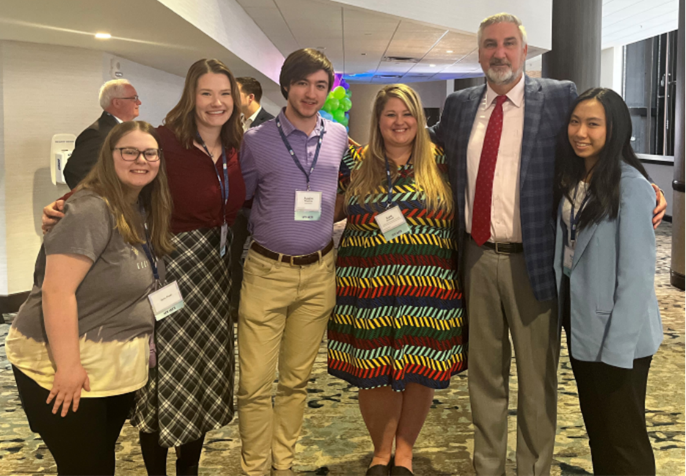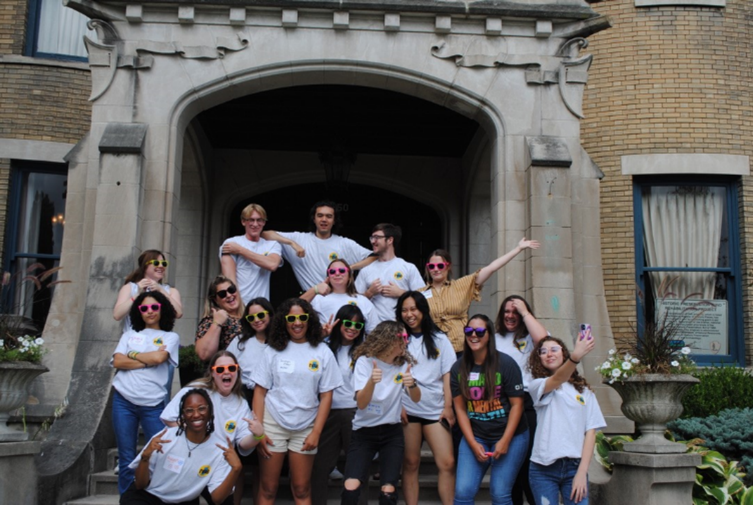Youth movement: IDOH, FSSA partnership gives young people a voice – and jobs -- in public health
A partnership between the Indiana Department of Health (IDOH) Division of Maternal & Child Health (MCH) and the Family and Social Services Administration Division of Mental Health & Addiction (FSSA-DMHA) is providing young Hoosiers with their first paid jobs in public health, as well as opportunities to improve health and wellness throughout the state.
Kate Schedel envisioned what would become the Indiana Youth Advisory Board almost as soon as she joined IDOH about five years ago. She spent prior years working in maternal and child health or infant mortality in places like the Dominican Republic, Guatemala, El Salvador, Mexico, and Albania. In 15 years of globetrotting (and as a member of the Peace Corps) the main constant she discovered was the impact young people were making.
“I just love working with youth, and I felt like those experiences made me want to always involve their voices,” said Schedel, Maternal & Child Health programs director. “Youth are the future.”
It so happened that a partnership with DMHA and the Association of Maternal & Child Health Programs (AMCHP) formed a foundation to bring that proposed future into the present.

Caption: MCH Programs Director Kate Schedel (fourth from left) is pictured here with Indiana Gov. Eric Holcomb and members of the Indiana Youth Advisory Board. The goal is to give young people a voice in public health.
The future is now
That future is now for 45 young Hoosiers representing 22 different counties. All between the ages of 14 and 24, the first members of the Indiana Youth Advisory Board (IYAB) finished up their first full year in June and started their second in July.
The advisory board members work on any of four subcommittees, each with its own focus: mental health, reproductive and sexual health, minority health, and access to healthcare. No matter an individual’s focus, however, they hit the ground running.
During IYAB’s debut year, the group presented at the lieutenant governor’s mental health roundtable; shared Youth Risk Behavior Survey data with school boards, created a poster presentation at the National Adolescent Health Initiative’s Conference in Michigan, spoke on a panel for Public Health Day at the Indiana Statehouse; and recently helped write a federal grant application. The IYAB members also learned valuable skills they can begin applying in their communities, and will soon learn suicide prevention techniques and how best to help someone experiencing mental health challenges.
Board members are paid via a funding mechanism through DMHA and can work up to 10 hours per week. They kicked off their second year with an event at The Children’s Museum of Indianapolis. The sophomore session kept the same roster of board members, which itself had to be whittled down from 229 total applicants.
The number of young people interested was a pleasant surprise for Schedel, who held high hopes with tempered expectations.
“I would have been happy if 10 people had applied,” she said.
With that modest forecast surpassed several times over, it was no easy task to narrow the field down to 45 successful candidates, Schedel explained, and those who made the board did so by offering compelling solutions to health issues that are of great importance to them. Schedel said lived experience was just as important as academics in the board selection process, and the group represents young people with distinct backgrounds in just about every corner of the state.
Giving youth a voice
Giving voice to youth has been a primary goal of Schedel’s since she came to IDOH, and the IYAB provides a megaphone for young Hoosiers to sound off about what matters to them. After all, they know their schools, their communities, and the public health challenges faced therein better than anyone.
“They are a very bright group of young people,” Schedel said. “They give me a lot more confidence in our future.”
She also has a great deal of confidence in the MCH employees who are heading the program, Adolescent Health Administrator Lindsay Williams and Adolescent Coordinator Samantha Mundt, both of whom, like Schedel, believe wholeheartedly in making such a platform available to young people.
Much of Williams’ involvement has centered on supervision of the group, the planning of IYAB meetings, and overseeing the Access to Care and Services IYAB subcommittee. She recently brought on a Youth Engagement Coordinator and assists Mundt with what she refers to as “mini projects.”
“Currently, all the work that I’ve been doing is really supporting Sam and the outreach part of things,” Williams said.
Mundt joined IDOH following an internship and quickly fell into a groove in her full-time role, much of which involves public-facing aspects of IYAB, like what she called “creative and big-picture planning.”
“I’m very fortunate to get to work on those projects,” she said.

Caption: The IYAB group has a bright future (hence the shades), and organizers within MCH are heartened by the impact the young board members are having on public health in Indiana.
A foot in the door
Williams noted that many young people take on jobs in retail or food service, though they may have no intention of staying in those positions long-term. IYAB offers students a chance to get a paid job in a public health field, which may be more closely aligned with that person’s career aspirations.
Not discounting the importance of such work, Williams mentioned that one of her goals is to “give the youth more experiences in actual career paths,” as she feels that working in positions that far removed from their ultimate career destination means students go into college or a trade school “not really knowing what they want to do because they’ve never been exposed to anything.”
Just as important to Williams is the effort to make certain those young people come to learn that there are many others throughout the state just like them, and they may have experienced many of the same challenges.
“I feel like a lot of youth years are spent not really relating to anyone because you feel like you’re alone and in this ‘bubble,” she said. “And I hope that this kind of experience shows them that there are other people that are experiencing similar things -- or maybe even the same thing that they are.”
Mundt feels similarly and is enthusiastic about IYAB, having been involved with it since her internship with IDOH. Following that, she joined the health department full time and has helped shape the course of IYAB around the ideas of its members. It’s been a win-win for all involved.
“I really have enjoyed working across the adolescent space, from my internship to my full-time position,” said Mundt, who reiterated that involving young people in the public health realm should be second nature.
“For me, it's a lot about making sure that youth voices are engaged when we make decisions that are about them,” she said, noting that large- and small-scale policies and practices alike effect adolescents.
A learning experience
Schedel called her and her team’s work with IYAB “a really good learning experience for everyone.”
She noted that much of the IYAB work occurs outside of regular work hours and is an additional responsibility, but the results make all the extra effort more than worth it.
“It’s the best part of my job,” she said.
Story by Brent Brown, Indiana Department of Health